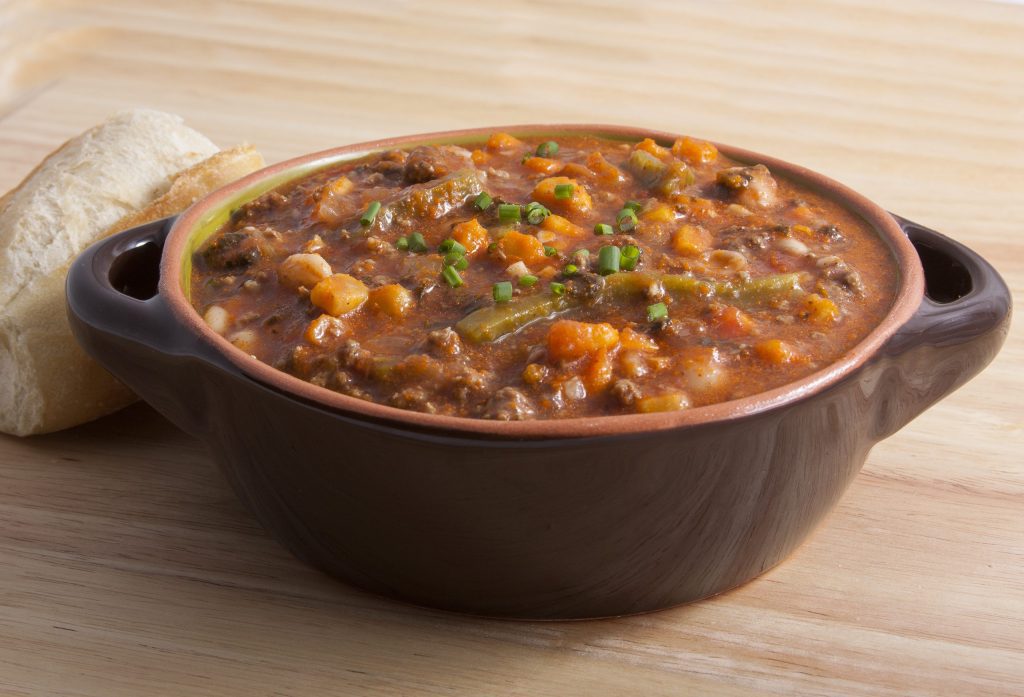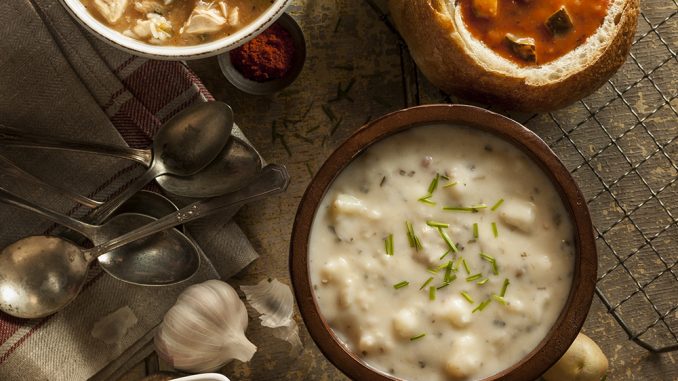Warm Up To Soups This Fall
October 1, 2019 | 10 min to read
Soup has evolved from a simple remedy for sickness to a versatile meal choice favored by consumers, particularly in the fall. Key trends include an emphasis on healthful ingredients, gluten-free options, and the addition of grains and functional foods, as noted by industry leaders like Ashley Albert and John Becker. With year-round demand increasing, fall has shifted to being more of a promotional time for soup, showcasing bold flavors and healthier, plant-based offerings.

Soup was once the go-to meal when someone was sick or wanted to warm up after a cold day, but the modern consumer understands soup is so much more than it once was. Thanks to a variety of interesting flavors and different ways to buy soup in the deli department, soup has become a must for stores looking to succeed.
This is especially true in the fall months, when many of the major soup companies release new tastes for the season, and people’s minds start turning to soup for meals.
“Today, when people reach for soup, they’re looking for something nourishing and wholesome and comforting, but more and more, they’re also looking for something healthful, with a clean label and all-natural ingredients,” says Ashley Albert, co-founder of the Matzo Project, headquartered in Brooklyn, NY.
Soups usually have protein, some sort of starch (noodles or rice), vegetables and a nutrient-rich broth, so it is considered a complete meal solution for many.
John Becker, senior director of marketing for Sandridge Food Corp., Medina, OH, says a trend developing in fall soups revolves around grains and other functional foods as ingredients, which continue to drive product development.
“Soups are a great category to introduce on trend ingredients,” he says. “And gluten free continues to drive demand. Beans and vegetables help with functionality.”
Bob Sewall, executive vice president of sales and marketing for Blount Fine Foods, Fall River, MA, has seen double-digit growth in both hot and cold soups, and is happy the category is so strong.
“Truthfully, fall soup is becoming less and less of a thing because people are now eating soup year-round, so now it’s about an everyday sell,” he says. “Not that it’s not important. We may use it as a time to change a couple of flavors out, but it used to be fall was just the beginning of the soup season, whereas now it’s more of a promotional time for soup.”
Sandy Rega, vice president of marketing and sales planning for Kettle Cuisine, headquartered in Lynn, MA, says fall is all about warmth and comfort with bold flavor twists, such as chipotle peppers, ginger and apple.
“Today’s consumers are also looking options which provide a healthier spin on classic comfort,” she says. “Plant-based offerings provide consumers seeking protein-packed foods a satisfying alternative.”

Following the Trends
John Cummins, director of culinary development/executive chef for Winter Gardens Quality Foods, headquartered in New Oxford, PA, says he’s seen a strong emphasis on fall soup classics come back in fashion recently.
“Some of the things we have put in development this fall is a version of the Beef Bourguignon soup, things that are rich and heavy, with mushrooms, onions and bacon,” he says. “Also, a Coq au Vin, a traditional French entrée, made with ground chicken, mushrooms and bacon, but taking those ingredients and turning it into a soup for retailers.”
Another fun and hearty item that he believes is popular in supermarket delis is the company’s Bacon Cheeseburger soup and a new Beer and Cheese soup that has been well received.
“We also have a few squash soups, and vegetable soups always make a strong showing in the fall,” says Cummins. “We are launching some things this spring, such as a skinny version of our Broccoli-Cheddar soup, which is lighter in calories.”
Another trend Winter Gardens Quality Foods is seeing comes from what’s happening in the foodservice realm, where broth-style Asian soups are finding their way onto more restaurant menus. The company is hoping to launch its own Ramen-style noodle soup in the months ahead, looking to satisfy the demand for healthy and low-fat soups.
In response to the recent trends it has noticed take root, Sandridge Food Corp. has released several new flavors of soups that address Millennial demands, whether through more global flavors like Thai Ginger Carrot, functional offers like Vegetarian Black Bean or through superfood ingredients like its Chicken Quinoa and Kale or Sweet Potato Kale.
In addition, the company relies on old staples this time of year.
“Roasted Pumpkin and Apple is a seasonal item that does very well,” says Becker. “Our Butternut Squash Bisque became such a strong seasonal flavor, we have now made it available year-round. Our chili category continues to grow, especially our Cactus Chili, a sweet chili made with traditional ingredients, accented with corn and pickled cactus.”
At the moment, the Matzo Project exclusively sells its Matzo Ball Mix and Matzo Ball Soup Kit, so they are both staples for the fall. Albert says the company’s Matzo Ball Soup Kit hits all of the marks today’s demanding supermarket customers are looking for.
“It’s one of the only soups in its category that is simultaneously all-natural, vegetarian (the broth is vegan), kosher and MSG-free while still being richly flavored and legitimately delicious,” Albert says. “Add to that the fact that it’s easy to make and I’d say we’ve got a trendy fall soup on our hands.”
Blount Fine Foods has been working hard on the ingredient side of its soups to get fresher ingredients and improve the quality of all its soup offerings. A new flavor it has launched for the fall season includes Cauliflower Parmigiana.
Kettle Cuisine employs numerous food experts who are constantly searching for and trying new concepts and ingredients.
“We are invested in long-term partnerships with world-class data and research organizations with access to both qualitative and quantitative research,” Rega says. “As leaders in the fresh soup industry, we are committed to help our customers develop a successful soup program, working with them to determine the right mix of flavors, sizes, prices and promotions for their operation.”
While the core rotation of flavors, such as Tomato Basil and Broccoli Cheddar, are still main staples in the fall, when it comes to seasonal-specific flavors, the company offers a Spiced Pumpkin and Hot Honey & Butternut Squash Bisque.
“We are finding that consumers not only look forward to a spiced pumpkin or butternut squash soup, it is expected as a main staple time of year,” says Rega. “Our Quinoa & Sweet Potato Chili with Black Beans is also a seasonal favorite that hits on all the top trends. We are also finding a lot of success with exciting world flavors, such as Moroccan Lentil Stew with Harissa and Black Lentil & Roasted Garlic Dahl.”

How Best to Sell
In the supermarket deli, there are several ways that soups can be sold. Not only can they be made available behind the deli counter, served both hot and cold, but soup bars are becoming extremely popular, as many retailers are finding the value of adding extra space for hot soup offerings.
“Hot bars are a primary location for immediate consumption,” says Becker. “Many operators also bundle single-serving sizes with sandwich options in the grab-and-go area. We also have some retailers who utilize soups as a component of their meal program. For example, our White Chicken Chili can be a nacho topping, and Lobster Bisque can be used as a unique sauce over fettuccini.”
The primary volume of soup still comes from hot wells, with fresh soup being a complement to hot bars, not a competitor. And don’t think those kettles are just for soup. Becker notes Sandridge Food Corp.’s White Macaroni and Cheese makes a great option in the soup well.
Becoming a Soup Destination
As more Millennials shop for lunches and dinners for one, employing some sort of soup destination is a great way to attract people to the store and the deli department, as many people see soup as a healthy meal or side dish.
A robust grab-and-go selection helps capture incremental sales for a different meal occasion.
Sandridge Food Corp. has seen good success with operators who offer a base menu of flavors available every day, but also offer some daily specials to create some excitement.
“Publishing menus in advance also helps shoppers create intended visits,” says Becker. “Our soups are refrigerated, fully prepared and ready for service. There is essentially no labor in preparation. Out of stocks are reduced with the ability to quickly restock items. A well-executed soup program adds sales and margin dollars to the P&L.”
Cummins notes that soups sell best in the deli section, and although some retailers have experimented with putting soups in other areas of the store, most times they quickly return to the deli area.
“Soup is a good product, and shrink is very minimal compared to other products sold in the department,” he says. “It stays fresh, and the margins for retailers are very favorable.”
Soup’s Evolution
The snacking trend that has defined the younger generations over the last couple of years fits perfectly with the soup category.
“Many consumers are eating less complete meals, but eating more times per day,” says Becker at Sandridge Food. “Soups are a great solution to a snack, providing needed calories and protein.”
Albert notes that soup is also a great vehicle to toss in leftover celery, carrots, onions and roasted chicken scraps to reduce food waste and is also a non-committal way for delis and their guests to explore different cultures and flavors from around the world.
“It’s a great, low-fat add-on to beef up a meal for people counting calories, and who doesn’t love to order a soup and half sandwich combo? It’s a classic,” she says.
Bros says most supermarket customers have pretty significant hot bars and offer numerous soup options around the deli.
“We try to offer the same product in a retail pack, whether it be a 16-, 24- or 32-ounce,” he says. “That’s also sold in the supermarket deli section close to the prepared foods. It’s really grown significantly in the last five years.”
Sewall agrees that soup is more popular today because it fits the healthy and clean look that consumers are seeking in 2019.
“As long as the label is clean and easily read with good ingredients, it’s really helping to drive it,” he says. “For people who may be snacking more, soup is portable and is a great snack for work, school or at home. The convenience of it has helped drive the category, plus the variety available is amazing. You can have a different flavor three times a day, seven days a week. It really fits today’s busy person’s lifestyle as well as their dietary goals.”

Soup Companies Play a Role
Many of the soup companies know they need to do their part to attract people to soups this fall, which is why there have been new ad campaigns on television and social media.
For example, Campbell Soup Co., based in Camden, NJ, recently teamed with NFL players Dak Prescott and Saquon Barkley for a new fall promotion. The campaign, entitled “Champions of Chunky,” is an updated version of the company’s classic Mama’s Boy campaign from more than 20 years ago.
The spots feature the NFL stars and their respective “champions” who interrupt them on game day—at a press conference, in the locker room and on the sidelines, to make sure they’re filling up right with a bowl of Campbell’s Chunky soup.
“We all have champions in our lives who play a huge role in our success—whether that’s a parent, sibling, grandparent, spouse, stepparent or friend—and this campaign recognizes those individuals who support us every day,” says Gary Mazur, director, brand marketing for the company.
It’s creative content like this that keeps soup on the minds of people throughout the NFL season, and supermarket delis can capitalize on this by bringing promotional items into the store set up by the soup bars.

Packaging Options
When it comes to packaging, Becker shares this is an area where there has not been much innovation.
“I would like to see packaging companies spend more time in this space,” he says. “We see several innovative options in Europe, but few domestically.”
Sewall says some of the larger containers that delis are offering, such as the 32-ounce containers, has made it possible for more families to consider soup in the home as a meal, mostly to serve with bread or salad as a meal.
Portability is a big factor in soup’s rise, and the packaging does play a big part in that, which is why many delis offer easy-use cups and bowls for soup to be scooped up, and many of these are environmentally friendly, which is also a big plus among today’s consumers.
“You can eat soup in your car, you can eat it at your desk, you can take it home in a bowl, so there’s a practicality to it, and I think economically, to scratch-make good soups takes a lot of effort and takes time, so there’s a real perceived value to being able to buy soup and enjoy a quality, healthy product at a good price,” says Cummins. “With the offerings of more and more fresh-prepared meals, it fits nicely in the supermarket deli and has really helped grow the category.”
This creates opportunity for delis. DB
9 of 9 article in DeliBusiness Oct/Nov 2019

